Multifunctional polymeric materials and use thereof
- Summary
- Abstract
- Description
- Claims
- Application Information
AI Technical Summary
Benefits of technology
Problems solved by technology
Method used
Image
Examples
example 1
Synthesis of Poly(4-hydroxystyrene) PHS-Bsed Terpolymer
This example demonstrates the synthesis of a PHS-based terpolymer containing 25 mol-% vinylether substitution and 17 mol-% 9-anthracenemethanol substitution. Poly(4-hydroxystyrene) (about 20 g) is dissolved in about 200 mL of anhydrous acetonitrile. To this solution is added p-toulenesulfonic acid (about 0.55 g) and 9-anthracenemethanol (about 6.1 g). The solution is stirred under a blanket of nitrogen and heated at reflux for about 16 hr. The solution is allowed to cool to room temperature, neutralized with aqueous ammonium hydroxide, and added with vigorous stirring to about 2 L of water. The resulting precipitate is collected, washed with water, and dried under vacuum. This material (about 7.5 g) is dissolved in about 75 mL of dimethyl sulfoxide (DMSO) with potassium hydroxide (about 1.4 g). The solution is heated to about 70.degree. C. under a blanket of nitrogen for about 30 min. A solution of 2-chloroethyl vinyl ether (abo...
example 2
This example demonstrates a one-component underlayer formulation and thin film prepared therefrom. The polymeric material described in Example 1 is dissolved in propylene glycol monomethyl ether acetate to provide a 20 wt-% solution, that is subsequently filtered to remove particulate matter. This solution is then cast onto a suitable substrate such as a silicon wafer using conventional spin casting techniques. A post-application bake is used to remove casting solvent. This baking step may also be used to initiate crosslinking reactions within the polymeric matrix. Alternatively, a second baking procedure maybe employed to thermally trigger the crosslinking reaction. Alternatively, exposure to actinic radiation or a beam of ions or electrons maybe used to trigger the crosslinking reaction. Also, a sequence of baking and exposure steps may be employed similarly. After this treatment, the film is suitably cross-linked into a polymeric network or to a degree that the increase in molecu...
example 3
The following example illustrates calculations for obtaining optimum bottom layer parameters of a bilayer system. Parameters are optimized so as to reduce reflections at the resist / underlayer interface. Computations are based on algorithms which use the Fresnel coefficients as found in standard textbooks such as Optics, by E. Hecht and A. Zajac, published in 1979 by Wiley, pages 312 and 313. These simulations can be extended to many different structures and they are not limited by the examples given below. The structure simulated in this example includes a Si substrate, underlayer, and photoresist. The parameters under investigation are the bottom layer optical constants n and k and film thickness d. The imaging Si-containing resist index of refraction extinction coefficient k and film thickness are fixed and given by n=1.78, k=0.018 and d=2000 .ANG. at 248 nm. FIG. 1 shows reflectivity at the underlayer / resist interface at 248 nm as a function of underlayer thickness for different ...
PUM
| Property | Measurement | Unit |
|---|---|---|
| Percent by mass | aaaaa | aaaaa |
| Thickness | aaaaa | aaaaa |
| Thickness | aaaaa | aaaaa |
Abstract
Description
Claims
Application Information
 Login to View More
Login to View More - R&D
- Intellectual Property
- Life Sciences
- Materials
- Tech Scout
- Unparalleled Data Quality
- Higher Quality Content
- 60% Fewer Hallucinations
Browse by: Latest US Patents, China's latest patents, Technical Efficacy Thesaurus, Application Domain, Technology Topic, Popular Technical Reports.
© 2025 PatSnap. All rights reserved.Legal|Privacy policy|Modern Slavery Act Transparency Statement|Sitemap|About US| Contact US: help@patsnap.com



